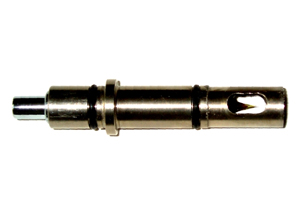ES-O2-M
O2-measuring instrument with galvanic micro-sensor
overview
Determination of dissolved oxygen without streaming the sensor membrane, parallel display of oxygen and temperature
The microprocessor-operated measuring instrument has been developed for the fast and accurate in-situ determination of dissolved oxygen without any sampling and without streaming the sensor membrane. The instrument is useful for the laboratory and for simple and fast measurements in the field. The instrument is equipped with a galvanic, membrane-covered dissolved oxygen micro-sensor and with a temperature sensor. The display shows both the concentration of the measured dissolved oxygen in mg/l or the oxygen saturation in % and the temperature of the sample.
The measuring instrument is powered via the included power supply unit and can also be operated with batteries. The RS 232 interface allows linking the instrument to a PC or notebook. By exchanging the oxygen sensor tip against the Amperometric hydrogen peroxide micro-sensor tip, the measuring instrument could be changed fast and simply into a high-performance H2O2 measuring instrument.
Furthermore, the instrument is useful for storing the calibration coefficients of up to 10 different chemical micro-sensors and for calculating the concentration units by means of the measured raw data. This also allows the fast and simple exchange of sensors and measuring ranges if required. Apart from the already mentioned micro-sensors for the determination of oxygen and hydrogen peroxide, there are also micro-sensors available for the determination of dissolved H2S/sulphide, hydrogen, and ozone. All these sensors can be interfaced very simply with the measuring instrument.
The measuring system is delivered with a case for transport and storage.
advantages of the DO measuring instrument with galvanic micro-sensor
Compared with the other commercially available so-called macro-sensors for the Amperometric determination of dissolved oxygen and compared with the volumetric Winkler titration, the new measuring device with galvanic micro-sensor has the following advantages:
- No streaming of the sensor membrane necessary because of the very low analyte consumption
- Very fast response time of the sensor (down to some hundred milliseconds for t90%)
- The sensor is self-polarising, ready for use immediately after switching on, no polarisation time
- Exchange of membrane and/or electrolyte is not necessary
- Determination without sampling or adding chemicals
- Very low detection limit: down to 0,05 % saturation or 4 μg/l
- Very high accuracy
- High economic efficiency (no chemical consumption)
- Measurements also in turbid, coloured, muddy and salt-containing samples
- Continuous online measurement (not only average values of a big volume)
- High local resolution of the measurement (μm-steps)
- Alternatively, display of oxygen concentration in mg/l or oxygen saturation in %
Fig.: Galvanic dissolved oxygen micro-sensor, complete with titanium housing, integrated electronic device and exchangeable sensor tip
specifications
| feature | specification |
|---|---|
| measuring principle | galvanic, membrane covered micro-sensor, self polarising |
| sensors | 3 sensor electrodes |
| no time delay | ready to use immediate after switching on the sensor |
| no steaming | no streaming of the sensor membrane, no sample stirring, very low analyte consumption |
| concentration ranges | variable on customers request standard: 0-150% saturation and others for concentrations of up to 150 mg/l on request |
| accuracy of the sensor | better than 2% of the measuring value |
| measurements | measurements within a temperature range of 0°C to 30°C |
| response time | t90%: down to some hundred milliseconds |
| average lifetime: | approx. 5...9 months |
| no signal interferences | no signal interferences in salt concentrations of up to 40 g/l |
| cross sensitivities | H2S (leads to errors and reduced lifetimes) |
| unsuitable for | unsuitable for measurements in strong alkaline solutions (c > 0,02 mol/l OH-), in strong acid solutions (c > 1 mol/l H+) and in organic solvents |
manual & docs
related products





